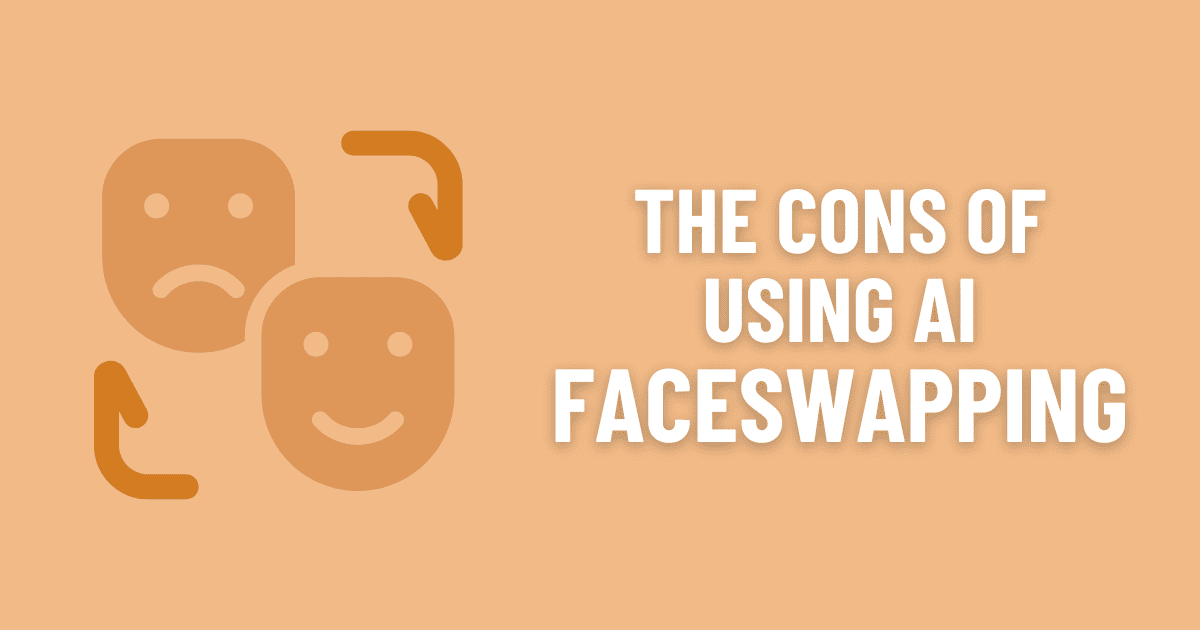I'm just a regular person who loves playing with new tech, and suddenly, I could swap my face into movies like "Blade Runner" or "The Shining" with just a few bucks per month.
It's crazy easy to use, too—just one click and you're set.
But the more I played around with AI face swap tools like DeepSwap AI (My review here), the more I realized it was a double-edged sword.
It's not all about creating fun memes or viral content; there's a darker side to this tech that we can't ignore.
In this blog, I'll explore the good and bad of AI face-swapping technology, drawing from my own hands-on experience.
How AI Face Swapping Works
Face-swapping with AI started with movie creators, but now, with a few taps on your phone or computer, anyone can do it.
Let's break it down simply:
The AI scans the photo to identify faces. It then converts the features of the face you want to swap into a digital code that captures its unique characteristics, like where the eyes and mouth are.
Next, the AI takes this digital version of the face and swaps it onto another person's head in the photo, making sure it fits naturally.
It adjusts for things like shadows and the direction the person is looking to make it look as real as possible.
This technology isn't only for laughs and creating wacky photos. It's also being used for more serious stuff, like security and healthcare.
While AI face-swapping is pretty impressive and opens up a lot of doors for creative and practical uses, it's not without its problems.
Let's explore these issues in more detail.
The Good: Advantages of AI Face-swapping

1. Entertainment and Creativity
Movies and Special Effects
AI face-swapping isn't just for making funny videos to share with friends. It's a big deal in movies too, especially when it comes to special effects.
Imagine being able to bring a classic actor back to the screen or letting a current star play a younger version of themselves. That's what this tech can do.
It's super helpful for filmmakers because it can save a lot of money.
Instead of spending loads of cash on makeup or hiring look-alike actors, they can use AI to swap faces.
According to Eisko, AI and deepfake technologies in film significantly reduce production costs and timelines, offering a practical alternative to traditional VFX techniques. [1]
For example, the traditional CGI process for creating realistic effects like aging or de-aging actors can be way too expensive, costing millions of dollars.
On the other hand, AI face-swapping technology can significantly reduce these costs, giving a more affordable solution that maintains high quality.
This cost efficiency is critical in the film industry, where budgets can quickly spiral out of control. [2][3]
It's making a huge difference in how movies are made and letting creators do things that were once impossible without breaking the bank.
Memes and Social Media Content
Think about it: with just a few clicks, anyone can now swap faces in photos and videos, making funny or creative images that can be shared online.
This is great for making people laugh, spreading joy, and even for getting a bit of attention on platforms like Instagram, Twitter, or TikTok.
Before this tech came along, you'd need some serious photo editing skills to pull off something like that.
But now, it's something almost anyone can do right from their phone or computer.
It's opened up a whole new world for content creators, making it super easy to come up with unique and engaging posts that stand out.
Plus, it's just a lot of fun to see your friend's face on a movie star's body, isn't it?
This simple, yet powerful use of AI is a great example of how technology is making creative expression more accessible to everyone.
2. Educational Purposes
Historical Recreations
AI face-swapping brings history to life in a way we've never seen before.
Imagine seeing historical figures in today's world or placing them into scenarios that never happened - like a famous leader giving a speech on modern-day issues.
This isn't just about fun or curiosity.
It helps us connect with the past in a personal way. By seeing these figures in action, we can better understand their expressions, emotions, and humanity.
Teachers can use this technology to make lessons more engaging, and filmmakers can create more authentic historical movies.
It's like a bridge between then and now, making history feel closer and more real to us.
Virtual Learning Experiences
Think about a science class where instead of just reading about astronauts, you can see yourself or your favorite characters floating in space, explaining how gravity works.
Or, imagine learning about the human body with a detailed, interactive model that looks like you.
It makes learning not just more fun but also more personal.
When students see themselves in the lesson, it's easier to pay attention and remember the facts.
Teachers can create lessons that grab your interest and stick in your memory. It's a game-changer for making tough subjects more accessible and exciting.
3. Advancements in Computer Vision
Research and Development
AI face-swapping isn't just a neat trick for videos; it's pushing forward a field called computer vision.
Computer vision is all about helping computers see and understand images and videos like humans do.
Thanks to AI face-swapping, computers are getting better at recognizing different faces, even when they change a bit.
This isn't just about swapping faces for fun; it's helping make computers smarter at identifying who's who in pictures and videos.
This advancement is super important for things like security cameras, photo sorting apps, and even self-driving cars, making them more accurate and reliable.
It's exciting to see how this tech is helping computers understand our world a little better.
Improved Algorithms and Applications
The evolution of AI face-swapping is marked by innovative tools that have found applications in various fields, enhancing creative possibilities and streamlining tasks.
For instance, Deepswap (My review here) offers highly accessible face-swapping for images, videos, and GIFs, while Face Swap by BasedLabs and AI Face Swap by Vidnoz provide realistic swaps with user-friendly interfaces.
Plus, Photoleap by Lightricks and HeyEditor focus on precise video face swapping, broadening the scope for creativity in digital content creation.
This leap forward is all thanks to the hard work of people who keep making these algorithms better and finding new ways to apply them.
The Bad: Disadvantages and Risks of AI Face-swapping

1. Ethical Concerns
When AI face-swapping uses someone's face without their okay, it crosses a line into privacy issues and raises ethical questions.
It's not just a simple case of using a photo in an unexpected way; it can lead to situations where personal images are misused, affecting people's lives and reputations.
This misuse can range from harmless pranks to more severe scenarios like identity theft or spreading false information.
It's important to remember the real impact on individuals' privacy and consent before swapping faces, emphasizing the need for clear permissions and ethical use of technology.
2. Deepfakes and Misinformation
AI face-swapping can create videos that look real but are completely fake. This means someone could make a video that shows people saying or doing things they never actually did.
It's easy for these fake videos to trick viewers, spreading lies or even hurting someone's reputation.
Imagine thinking you saw a video of someone you trust doing something bad, but it was all made up.
That's the kind of trouble AI face-swapping can cause when used the wrong way.
3. Identity Theft and Fraud
AI face-swapping can lead to serious issues like identity theft and fraud. Imagine someone taking your photo from the internet and using it to pretend they're you online.
They could trick others, get into your accounts, or even commit crimes under your name.
This technology also has the potential to fuel cyberbullying and harassment, making it easier for bullies to target individuals by manipulating their images in harmful ways.
This isn't just scary for individuals; it's a problem for society too. It shakes our trust in what we see online and makes it harder to know who to believe.
We need to be careful and protect our images to keep our identities safe.
4. Misuse in Journalism, Law Enforcement, and Legal Proceedings
AI face-swapping isn't just about swapping smiles; it has a serious side that can mess with important stuff like news, police work, and court cases.
Imagine someone creates a fake video that looks real and uses it to tell a lie in a news story, or to trick people into thinking a crime happened that didn't.
That's not just confusing; it's dangerous.
It can make people believe things that aren't true, which is a big problem for journalists trying to tell the real story, cops trying to figure out what actually happened, and judges trying to make fair decisions.
Plus, it can really hurt famous people when their faces are used in ways that make them look bad or do things they never did.
It's not fair to them, and it can damage their reputation big time. We've got to be careful with this tech, so it doesn't end up causing harm where it's meant to help.
Final Thoughts
We've taken a close look at both the positive and negative sides of AI face-swapping.
It's a powerful tool that can spark creativity but also carries risks like privacy invasion and misinformation.
The responsibility falls on us to use it wisely and push for smart rules that keep the bad stuff in check.
It's essential for everyone to play a part in using AI face-swapping responsibly and advocating for laws that safeguard against misuse.
This balance will help us maintain the benefits while mitigating the drawbacks.
